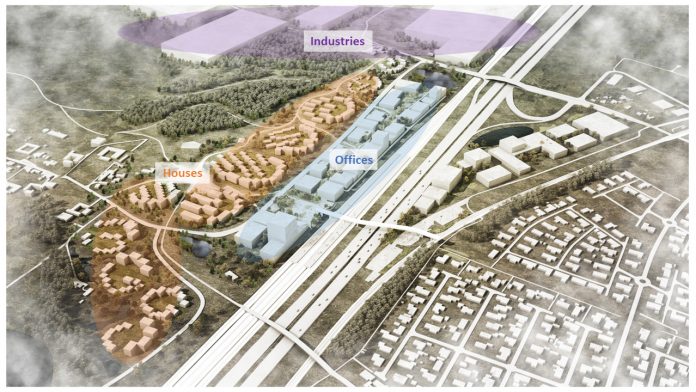Peder Vejsig Pedersen from European Green Cities describes a CO2 neutral city development based on Smart Energy Design Guidelines
For more than 15 years, European Green Cities has been the secretariat of the Danish Association of Sustainable Cities and Buildings, FBBB, with 18 Danish cities as well as housing associations and consultants as members. And in connection to this and the realised “Nordic Built Active Roofs and Facades” project, it has been possible to realise the sustainable building database, (also in English) with documentation of best practice building projects, which combine a focus on low energy design with the use of renewable energy solutions, and also with a view to ”performance documentation”. Here, there was also ongoing cooperation with the international “Active House Alliance”. And an outstanding result of this was the best practice BIPV demonstration project for the Copenhagen International School, CIS, which is also presented in the mentioned database, including the practical result of an online Active House Radar showing the development in continuous qualities concerning Energy, Comfort and Sustainability. This led to the international Active House Award in 2018.
Developing CO2 neutral communities
Since then, there has been made work on how to develop and model CO2 neutral communities practically within the Smart Energy Green Cities project coordinated by European Green Cities. Here, cooperation has been made with four different city areas in Denmark on how to optimise the energy supply system, f.ex with the electrification of district heating systems in combination with BIPV and PVT systems, also working with ATES systems in communities (Aquifer Thermal Energy Storage). A very interesting recent demonstration project concerning this is the use of ground water-based cooling for Bispebjerg Hospital in Copenhagen, where a 90% saving of electricity for cooling was obtained together with a 60% district heating saving with the help of large heat pumps using the heated groundwater. See the latest news here.
And at present, several Smart Energy systems are being developed as part of the Avedøre Green City cooperation, both for Avedøre Stationsby which has 2,000 apartments in concrete housing blocks from the 1960s, which will be renovated and for Avedøre Village, wherein both cases, low-temperature district heating with ATES will be combined with PVT-systems, to obtain an aimed at CO2 neutral city design. See here.
Activehouseroofsandfacades website. See the latest news on our European ‘Smart Energy Design Guidelines’ initiative here
As a special challenge concerning the use of BIPV in cities, we have seen that it is very important, as part of models for “performance documentation”, to include detailed documentation work concerning LCA and EPD’s for the used BIPV technologies. If you only use generic values, there will be a very limited effect on sustainable building certification (with DGNB, LEED or the Nordic Swan label).
When you look at the heating market in Denmark, where more than 60% involves the use of district heating, the main energy source today is biomass, and unfortunately not always based on sustainable sources, since f.ex city areas like the Larger Copenhagen region is dependant on large imports of wood pills from foreign countries. This is a better choice than the former use of imported coal, but still not an acceptable solution for the future.
And if you look at the general situation in Denmark with respect to meeting the needed and agreed CO2 emission reductions in connection to the energy supply, there are clear visions on how to provide centrally produced renewable energy solutions by help of large offshore windmill parks and similar solar parks in the countryside, for the common electricity system. But when it comes to visions on how to incorporate locally produced renewable energy, there is, like in most other places in Europe, not such a clear strategy.
This is despite the fact that it is very important to secure local involvement when you want to obtain a zero CO2 emission society in practice. An aim to introduce local renewable energy solutions will at the same time support reduced connection and transmission costs, while it also reduces energy system losses and provides a better energy supply security.
To ensure a more successful introduction of local renewable energy solutions in practice, it is the vision of European Green Cities, www.europeangreencities.com to create a partnership to develop actual CO2 neutral communities, based upon an agreed toolbook, in connection to what we define as ”Smart Energy Design Guidelines”.
From a European perspective, it is important to note that the European Green Cities organisation, has had long term cooperation with the SIR organisation from Salzburg in Austria since they were partners in a large European targeted demonstration project that started in 1996. And from 2007 both organisations were also partners in the EU Concerto large scale demonstration project, ”Green Solar Cities” for a 6 year period, focussing on Copenhagen and Salzburg. See here.
From this cooperation it has been clear, that when you look at how to incorporate local renewable energy solutions, the situation in the Salzburg region has led to a special focus on how to utilise the large amounts of local biomass resources in a sustainable way, and then combine this with use of solar thermal heating, often in combination with local district heating networks. At the same time, the focus on using PV systems has until recently only been limited, due to the available large hydropower resources in Austria. It can also be noted that the use of new and innovative technologies have emerged, like f.ex the ”Voll Solar” concept, which combines a high solar thermal contribution with an electrical-based backup in a cost-effective way, a little like what has also been seen in Norway, where large hydropower resources are also available.
Please note: This is a commercial profile












